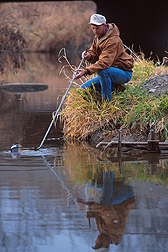USDA to Assess Environmental Benefits of Conservation Programs
- In-depth studies to be conducted in 20 watersheds
By Sean Adams
July 22, 2004
WASHINGTON, July 22--Agriculture Secretary Ann M. Veneman today announced a five-year effort to study the collective environmental benefits of government conservation programs on agricultural land.
"The advantages of conservation programs are widely recognized, from reducing soil erosion and enhancing water and air quality to promoting wetland and wildlife habitat preservation and restoration," Veneman said. "However, the environmental benefits of these programs have not been previously measured at the national level. This effort will provide an accounting of the benefits achieved through conservation programs."
Through the Conservation Effects Assessment Project (CEAP) the Department of Agriculture will study the environmental benefits of conservation practices implemented through 2002 Farm Bill programs: the Environmental Quality Incentives Program, Wetlands Reserve Program, Wildlife Habitat Incentives Program, Conservation Reserve Program, Conservation Security Program and Conservation Technical Assistance.
CEAP is composed of two basic parts: a nationwide assessment of conservation benefits and more in-depth studies of these benefits in 20 selected watersheds.
The national assessment will be reported annually starting in 2005. USDA's Natural Resources Conservation Service's (NRCS) National Resources Inventory will be used as the sampling basis for estimating the environmental benefits of conservation practices, as well as farmer surveys and existing USDA computer models.
In-depth studies within eight special-emphasis and 12 benchmark watersheds (details below) will occur simultaneously with the national assessment and other on-going watershed research efforts. NRCS selected the special-emphasis watersheds to address specific concerns such as manure management on animal feeding operations, water use on irrigated cropland, drainage management, wildlife habitat and riparian restoration. These watershed studies also should help develop performance measures for estimating soil quality, water quality and wildlife habitat benefits for specific conservation practices.
USDA's Agricultural Research Service (ARS) has been conducting research on most of the 12 benchmark watersheds for a considerable period of time and anticipates that watershed-scale research and assessments will be continued over many years.
In addition, the USDA Cooperative State Research, Education and Extension Service in April 2004 issued a notice to accept applications for competitive grants for additional CEAP watershed studies.
Additional information about CEAP can be obtained at http://www.nrcs.usda.gov/technical/nri/ceap.
|

